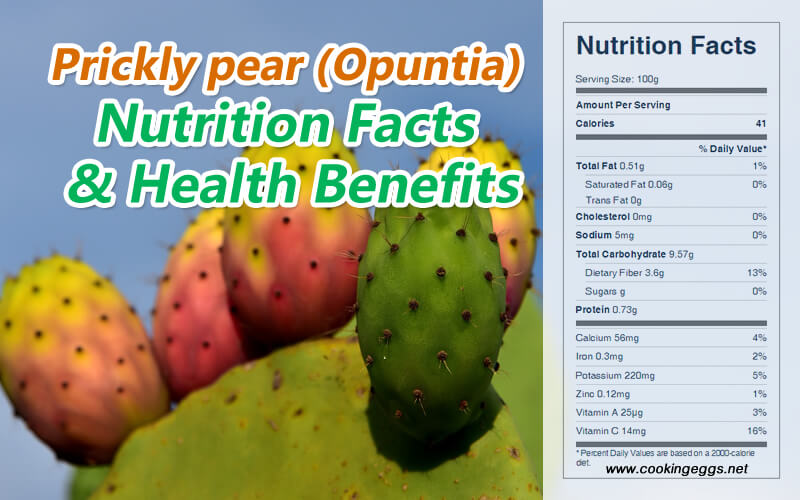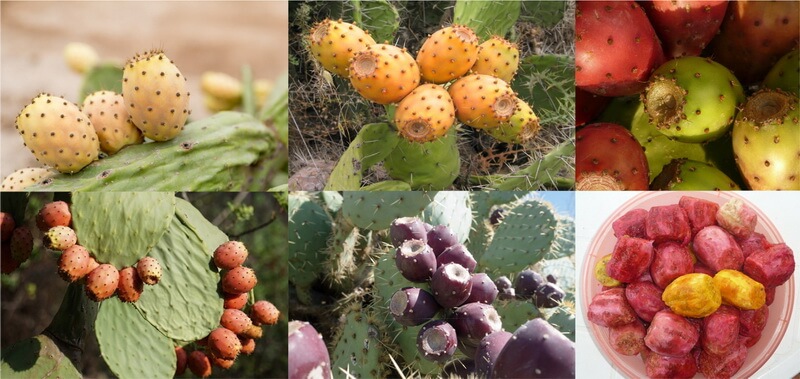Prickly pear (Opuntia) Nutrition Facts & Health Benefits
Warning: A non-numeric value encountered in /www/wwwroot/www.cookingeggs.net/wp-content/plugins/nutrition-facts-label/nutrition-facts-label.php on line 384
Opuntia, commonly known as prickly pear or pear cactus, the prickly pear fruit also known as tuna, have been used for centuries as common vegetables and medicines by Native Americans and Mexicans to treat a variety of ailments and disorders. Prickly pear is a multipurpose crop, not only providing food and feed but also being a source of health-promoting substances that can be used as natural plant-based drugs to prevent diseases.
The cactus pear fruit has an oval, elongated shape, like an oval apple or pear, and is a fleshy berry. The fruits have several colors, such as white, green, yellow, orange, red, and purple, which vary in relation to the amount of betalain pigment content. These pigments have antioxidant properties, and their concentration is responsible for the differences and intensity in color types of the fruit.
Nutritional Value of Prickly Pear Cactus
The prickly pear fruit contains approximately 87% water, 10% carbohydrates, 0.3% ash, and less than 1% protein and fat. The fruit of prickly pear cactus contains significant amounts of vitamin C (ascorbic acid), vitamin E, carotenoids, dietary fiber, amino acids (alanine, arginine, and asparagine), and antioxidant compounds (flavonoids, betaxanthin, and betation) while having hypoglycemic, hypolipidemic, and antioxidant properties. It also contains large concentrations of taurine and minerals, such as calcium, magnesium, potassium, and phosphorous.
In a 100-gram reference amount, raw prickly pear cactus supplies 41 calories, 9.57 g carbohydrate, 0.73 g protein, 0.51 g fat, 3.6 g dietary fiber, 43 IU vitamin A, 14 mg vitamin C, 6 mcg folate, 56 mg calcium, 0.3 mg iron, 220 mg potassium, and 85 mg magnesium.
Additionally, prickly pear cactus contains important and diverse phytochemicals that have important medicinal properties such as antioxidants, including their high content of antioxidants (flavonoids, ascorbate), pigments (carotenoids, betalains), phenolic acids, and phytosterols. They have anti-inflammatory, antioxidant, hypoglycemic, antimicrobial, and neuroprotective effects.

Raw Prickly pear Nutrition Facts Label
Health Benefits of Prickly pear
A number of medicinal applications have been attributed to opuntia. Prickly pear components and extracts have been used in treatments for diabetes, cholesterol, and immune system health. Prickly pears have been used to protect brain tissue from glucose and oxygen deprivation and to treat hypoglycemic effects in diabetic patients by returning blood glucose to normal levels.
The antioxidant effects of the prickly pear may be due to several compounds which can be found in prickly pear fruits, such as quercetin, kaempferol, isorhamnetin, vitamin C, and carotenoids. Flavonoids are especially efficient as antioxidants due to their inhibitory actions on prooxidative effects on DNA, proteins, and lipids, as well as in preventing the generation of stable radicals. Prickly pear extracts have a higher antioxidant activity than other fruits like pears, apples, grapes, oranges, grapefruits, and tomato. The cactus’s antioxidant and free-radical scavenging properties could theoretically help to slow down the aging process if the stems were consumed with regularity.

Prickly pear can help with the prevention or slowing down of diabetes. Prickly pear is rich in pectin. The role of dietary fiber in glycemic control and specifically in type 2 diabetes is well accepted. A study has shown that the intake of prickly pear fruit improves postprandial blood glucose control as well as insulin and glucose-dependent insulinotropic peptide index. Furthermore, polyphenols found in prickly pear may lower the risk of type 2 diabetes and the burden of insulin resistance due to their multiple effects on carbohydrate metabolism.
The seeds of prickly pear cactus also possess potential medicinal value. The oil obtained from the seeds is rich in diverse phytochemicals and studies have demonstrated important antioxidant activity, especially against lipid peroxidation. The oil also showed various beneficial effects, including -glucosidase inhibitory activity, cytotoxicity against certain human cancer cell lines, antimicrobial action (especially against Gram-positive bacteria), antifungal activity, as well as analgesic and anti-inflammatory effects.
The raw stems of various species of the genus Opuntia contain abundant neutral mucilage (glucomannan), which is a complex carbohydrate that may delay the absorption of glucose and interfere with lipid metabolism. The cactus stem also contains fiber, as well as polysaccharide compounds that delay glucose absorption. The influence of prickly pear components in the prevention of several hallmarks of cardiovascular disease, namely atherosclerosis, dyslipidemia, and atherogenesis, can explain the potential protective effect of prickly pear in cardiovascular disease. The lipid-lowering effect has been explored in some studies. A dietary supplement including prickly pear has shown that the extract increases high-density lipoproteins while decreasing low-density lipoproteins, with this effect mainly being attributed to the dietary fiber pectin. In fact, pectin is well-recognized as a cholesterol-lowering fiber due to its double action in reducing reabsorption as well as promoting its excretion.